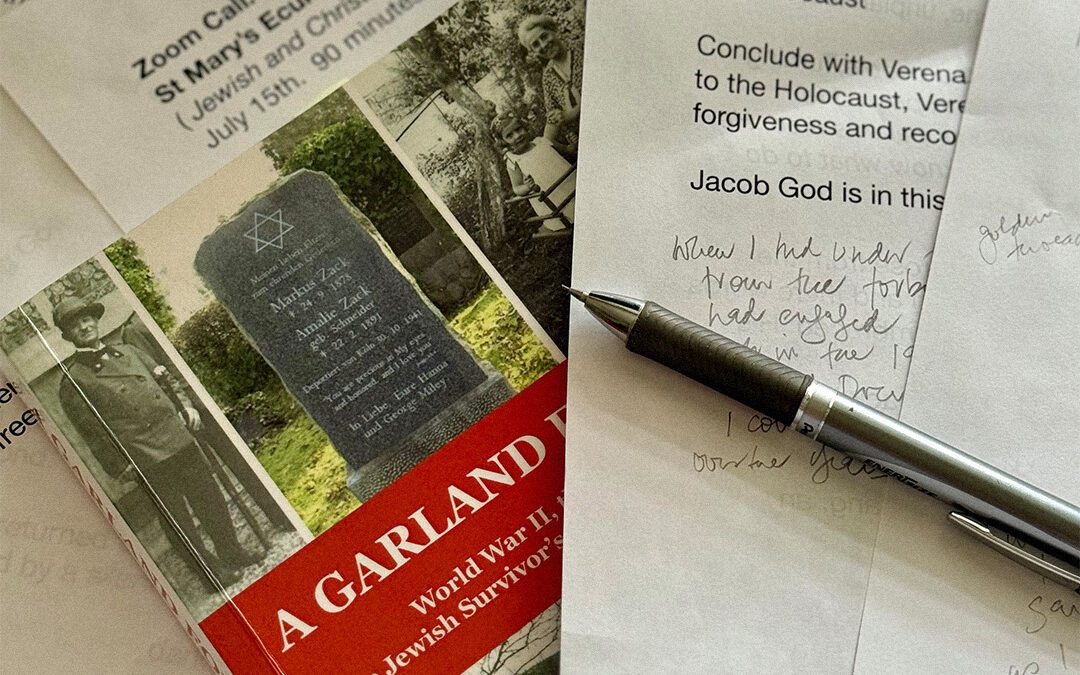The invitation to Zoom with students at St Mary’s Ecumenical Institute, Baltimore and speak on the topic: Jewish and Christian responses to the Holocaust, sparked my interest but mingled with thoughts of inadequacy.
And there I was, yesterday the 15th July sitting in front of the screen looking at 12 friendly, learned faces and I began…
Our title, Jewish and Christian responses to the Holocaust, resonates for me…I am Jewish, Christian and a Holocaust survivor. And yet to speak openly and honestly on this subject is not an easy task.
My people have a long history of displacement and loss…
From Jacob’s flight into the unknown after he deceived his father and robbed his brother.
Then his descendants left their home for Egypt,
seeking food during a time of severe famine.
Later generations undertook the long hazardous return journey home.
During the early childhood of Jesus, a time of
life threatening danger, his family fled with him to Egypt, escaping the murderous rage of the ruler.
All this gives the perspective of history to my little story, Thankfully it’s a long story although much too long for this zoom.
86 years ago on this day, July 15th, 1939, I was 7 years old living with my parents in the city of Cologne, Germany.
Some months earlier we had been displaced with all our Jewish neighbors from our small home town, Gemünd, which was then declared Judenfrei (Free from Jews).
The catalyst for our expulsion erupted during the night of November 9-10, 1938. Our community in Gemünd, endured Kristallnacht, like Jewish citizens all over Germany and Austria.
Jewish synagogues, businesses and homes were burned and pillaged and many Jewish men were rounded up and transported to confinement camps.
We had been experiencing sporadic antisemitic words and actions ever since Hitler became Chancellor of Germany on January 30, 1933 but with Kristallnacht the violence was coordinated nationally.
As we look back we are faced with an uncomfortable question,
What was the response of the churches? The Roman Catholic church, the Evangelische (Protestant) church and the Free Church, Baptist etc.
I have vivid memories of Jew hatred at my first school.
I remember the day we opened our new arithmetic books to find the brightly colored spinning tops and bouncing balls we regularly added and subtracted replaced by tanks, helmets and marching Hitler Youth carrying red and white flags with a strange black jagged shape at the center.
We were only a handful of Jewish children attending the local church school and on November 15, 1938, 5 days after Kristallnacht, we were expelled.
In a strange way our relocation to Cologne saved my life…twice.
By 1937 all Jewish doctors and medical staff had been dismissed from German hospitals and Jewish patients were no longer admitted. The only Jewish hospital in the region, still treating Jewish patients was located in Cologne. During a hot summer night in July, 86 years ago, I woke crying with pain and was rushed to that Jewish hospital for an emergency appendectomy. If we had remained in Gemünd…
My parents could no longer escape…but my father discovered a way out for me…the Kindertransport. Britain had agreed to accept 10,000 Jewish children, from Germany, Austria, Czechoslovakia and Poland…no adults.
Within walking distance from our apartment in Cologne, a Jewish office was located for making Kindertransport arrangements.
So despite my mother’s fear that I had not fully recovered from surgery, on the evening of Monday, July 24, 1939, I climbed the steep steps of the steam train standing by the platform at Köln, Hauptbahnhof, helped up by my parents who had told me I was going on a nice trip.
At the top I turned round and saw tears in their eyes and in that moment began a journey of loss, bereft of their love, security, language, culture all that was familiar.
For me the journey ended in Coventry, a British manufacturing city that was the target of the famous blitz, relentless bombing raids in November 1940.
How did I cope, in the home of a foster family who spoke no German? After initial disorientation I quickly learned English. It was wartime and any connection with Germany, even a foreign child, could evoke suspicion and so, I took on the persona of a nice English girl, looking for acceptance.
But deep inside there churned suppressed anger, denial, self pity…
In my 20’s as a newly minted teacher in a small West Sussex country school, I enjoyed the curiosity of the children and the pace of village life but like an Instagram selfie, I was projecting a a carefully composed image that belied my inner reality.
Until…it didn’t work anymore.
It was the spring of 1961 and for the first time I heard, really heard, the invitation to bring my inner darkness, my anger, hatred of Germans, my bitterness to God, to Jesus on the cross.
I was at the end of my rope and I took a first tentative step to express sorrow for my ruinous responses toward those who had wronged me.
I lifted the unbearable weight of it all up to Him.
It was my first visceral encounter with todays’s topic,
a Jewish / Christian encounter with the Holocaust.
A 100% Ashkenazi Jew, I turning to Jesus as my Messiah.
A watershed moment in my life, a sense of freedom and release.
In the following days, slowly, gradually the thought came,
I have been forgiven, what about my thoughts toward those who have wronged me?
It was one thing to bury my head in the soft arm chair in the apartment overlooking the High street, Horsham, Sussex with the English Channel between those descendants of possible perpetrators in the area around Gemünd and beyond and me, in southern England thinking good thoughts… but how to make it tangible?
What have been the instruments of healing for me, over the years, bringing my inner thoughts out into the real world?
From the many many vivid encounters with the past in Germany and Europe over the years I’ll pick 3 to share with you.
George and I were married in India in 1971,
by 1992 we were visiting Germany annually.
In March 2008 we were in Gemünd, walking back from the Jewish cemetery, with a good friend, Gerda Schaller.
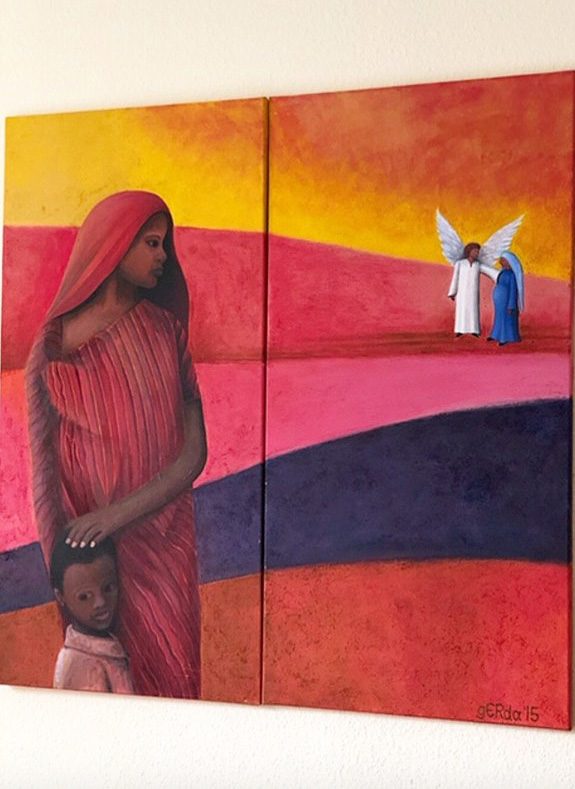
Hagar. Oil painting. Artist: Gerda Schaller.
As we were crossing the bridge at the confluence of two rivers, the Olef and the Urft, Gerda turned to me and said,
Hanna why don’t you write a book about your story?
It was an idea I had resisted for many years, unable to face the suppressed grieving…But at that moment Gerda’s question broke through and I began a slow process of remembering, researching, visiting the dark places of my family’s past.
Searching our history with open eyes, praying for the gift to forgive, finding words to describe what actually happened, so very painful but bringing the possibility of freedom.
Bonn is the city of my birth and in 2016 I was invited to join a group of Christians from the area and speak in front of the Bonn Rathaus, the City Hall, to conclude their remembrance march through the city to honor the former Jewish citizens.
What could I say in Bonn to a group of Germans trying to deal with their past and the role of their forbears?
I checked the date of this solemn remembrance ceremony, on 3rd May 2016.
My mother, Amalie Zack and my father, Marcus Zack were gassed in a grey van on May 3rd 1942 in Chelmno, Poland.
I knew I was supposed to read the account of their death recorded in my autobiography, A Garland for Ashes,
in the center of Bonn, on the exact Anniversary of their deaths, even though I was a little nervous about how the German audience would respond.
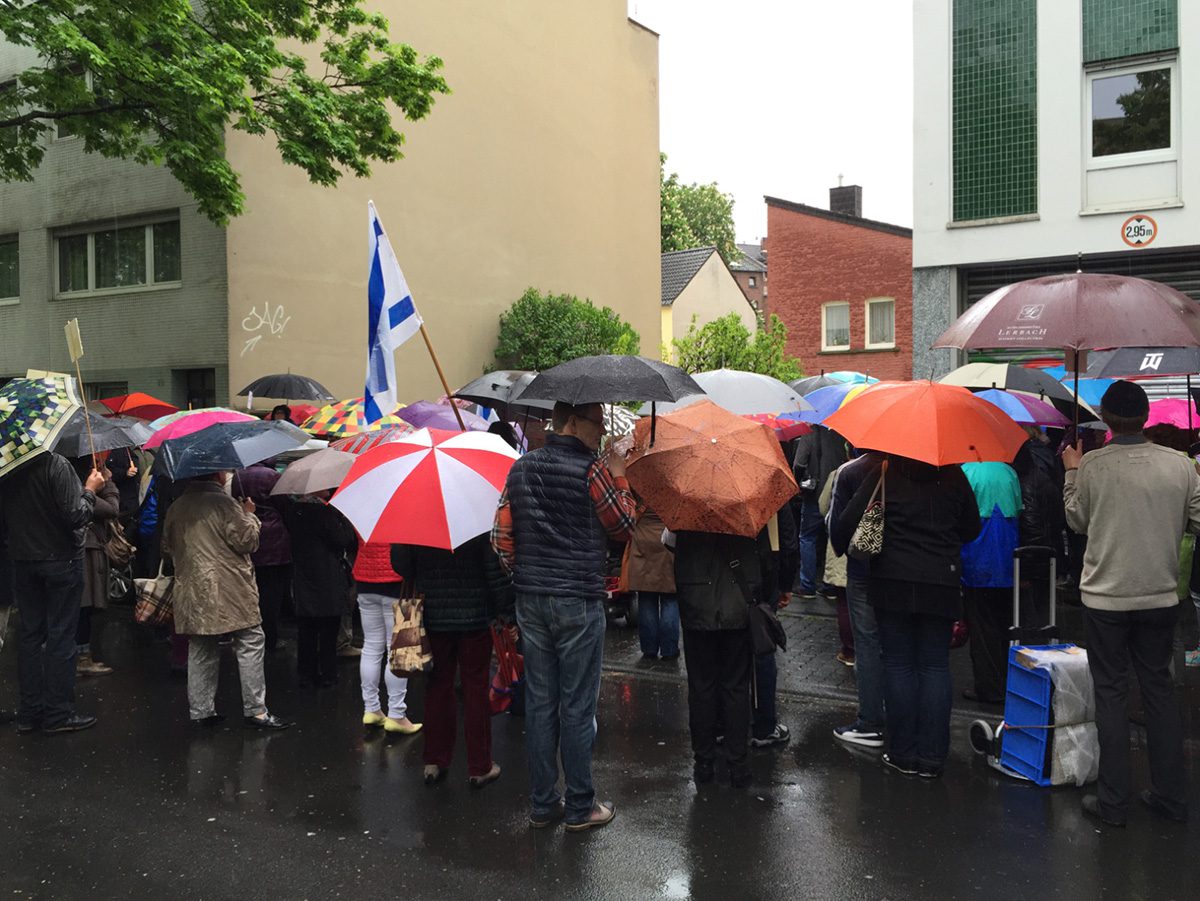
Stopping on the way to the Rathaus to honor the memory of a former Jewish citizen.
At the Rathaus I finished reading, the light rain continued to fall, I returned to my seat under the blue tarpaulin, surrounded by a silent crowd holding umbrellas.
A tall middle aged businessman came forward and approached the microphone…unplanned he started to speak.
My grandfather was in the SS, he killed people,
Turning toward me he said,
My grandfather was posted to Chelmno, he was there at the time your parents died.
He was a Nazi to the day he died.
I don’t know what to do with that I can only stand here and say the words my grandfather never said…
Will you forgive me?
The question hung in the air. He wept. I rose from the rickety chair almost propelled toward him and
these words were given to me,
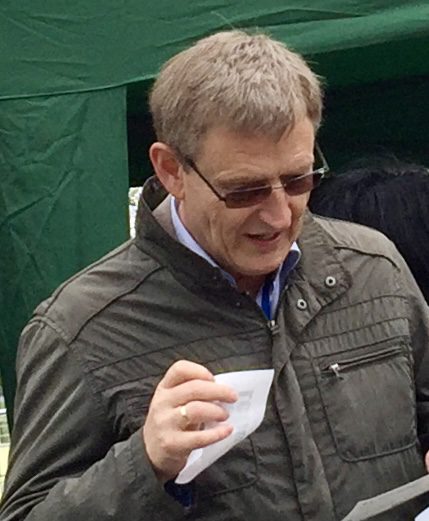
With Markus some weeks later in Berlin, we became friends.
I forgive you.
We embraced.
His name was Markus Demmer.
As I remember the dramatic encounter with Markus, I go back to England, to the Spring of 1961 when I asked the question,
What about those who wronged me?
Lastly, if you have been able to watch the trailer for i was 8814,
you will have met Verena Lang. She is an Austrian historian, musician and the closest of friends.
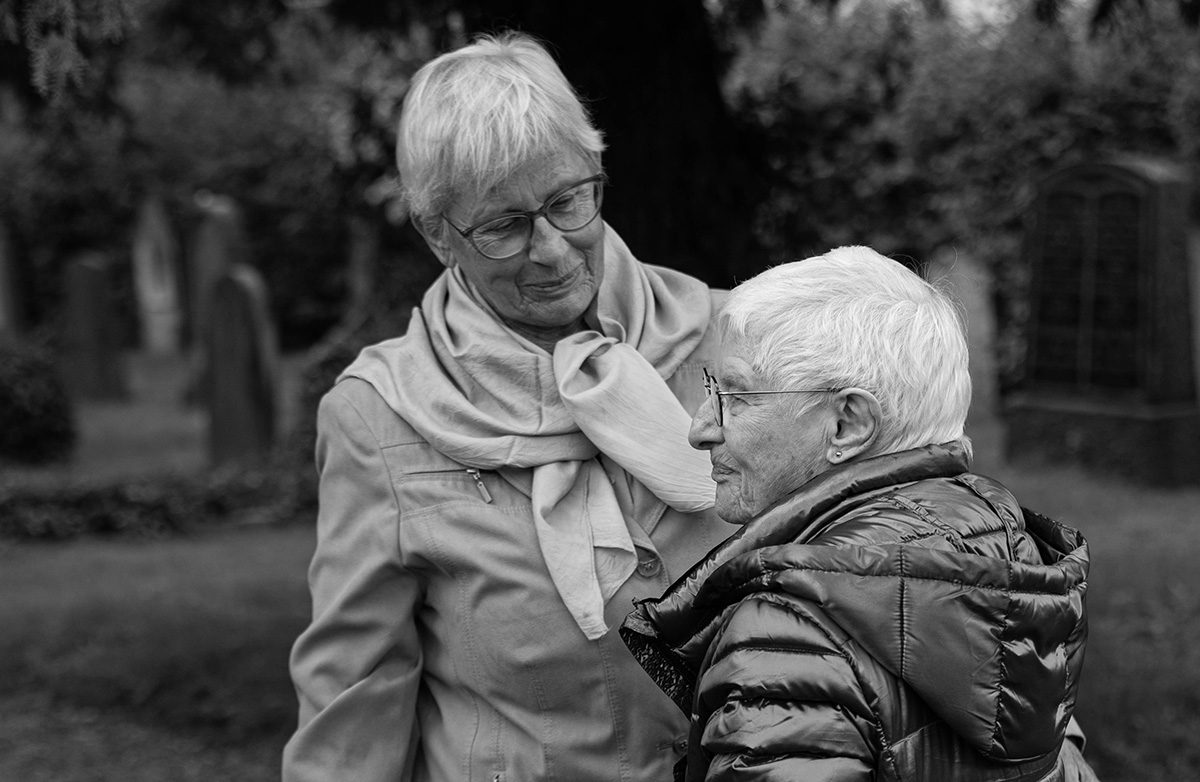
Verena and I filming i was 8814 in the Jewish cemetery, Gemünd. Photographer: Ryan Therman
Her father was an influential Austrian Nazi.
Verena spent years weighed down by the burden of guilt and shame, struggling with the acts of a father she had admired and loved before she understood.
In May, 2010 Verena and I travelled together to Chelmno, Poland.
There were 10 of us, we were a minyan and had come to recite Kaddish, a Jewish mourners’ prayer, at the incinerator in the forest on the Anniversary of my parents’ deaths.
First though, we had visited a nearby museum site in the village, where they had entered the grey gassing truck.
I wanted to pray at the exact spot where my parents’ had taken their last breath.
But it was a national holiday and the normally open gate was locked and there was no one to help.
We stood together at the gate looking through the bars at a barren piece of ground,Verena and I next to each other.
Suddenly she sank to her knees, weeping, asking God for forgiveness.
Each of us, one a Roman Catholic the other a Jew, experienced reconciliation, the taste of freedom from the darkness of our pasts.
That first night of Jacob’s flight into the unknown,
bereft of family, alone, he had an encounter with God
and said,
Surely the Lord is in this place, and I did not know it.

